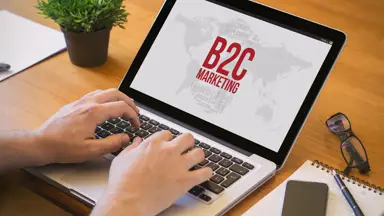What is B2C? How to Distinguish Between B2C and B2B
B2C stands for Business to Consumer, which represents the business model from businesses directly to consumers. This is one of the most popular business models today, particularly in the realm of e-commerce.
In this article, Aniday will introduce you to the concept of "What is B2C?" along with its characteristics, popular B2C models, methods for distinguishing between B2C and B2B, as well as the key to effectively utilizing the B2C model.
The definition of B2C

What is B2C? This is a business model in which a company provides products or services directly to end consumers. Businesses can sell through:
- Traditional channels: physical stores, supermarkets, bookstores, etc.
- Online channels: websites, applications, social networks, etc.
Consumers can select products or services based on their personal needs and preferences and make payments through methods like cash, credit cards, bank transfers, and e-wallets.
Characteristics of B2C

In addition to understanding what B2C is, it's equally important to grasp the nature of the B2C model, which includes the following properties:
- Large market scale: Reaching millions of consumers nationally or globally, unrestricted by geography or time.
- High transaction volume: Consistent sales, 24/7, with a diverse range of orders.
- Low transaction value: Because of selling low-value orders, ranging from a few dozen to a few hundred thousand dong, businesses must optimize costs and enhance operational efficiency to remain profitable.
- Quick purchase decisions: Consumers often make buying decisions based on emotions, attraction, and trust in businesses. Therefore, businesses must focus on building their brand, creating an impression, and enhancing their reputation with customers.
- High competition level: Businesses face fierce competition from rivals in the same or related industries. Therefore, businesses need to keep an eye on market trends, improve product or service quality, and differentiate themselves from competitors in the market.
Popular B2C Models

After gaining insights into what B2C is, Aniday would like to share some popular B2C models. Nowadays, businesses employ various B2C models based on their product or service type, sales channels, and profit strategies.
Here are some of today's most popular B2C models:
1. Direct Retailer
- Traditional B2C model
- Selling directly to consumers through physical stores, supermarkets, bookstores, or their own websites and applications.
- Businesses can either produce or import products themselves and profit from the price difference between selling and cost prices.
Examples: Thegioididong.com, Tiki.vn, Vinmart, Fahasa.
2. Advertising-Based Model
- Widely recognized in the fields of media, entertainment, and information.
- Businesses offer free or low-cost content to consumers and generate profits by selling advertising to third parties.
- Content can be produced in-house or acquired through copyright, and it must attract a large and loyal user base.
Examples: YouTube, Facebook, Zing.vn, VnExpress.
3. Electronic Intermediary Platform
- A prevalent B2C model in the e-commerce sector.
- Utilizes a platform that connects sellers and online buyers.
- Generates profits from collecting transaction fees, service fees, or advertising fees.
- Businesses don't need to maintain inventory or transport goods but must ensure transaction quality and safety on the platform.
Examples: Shopee, Lazada, Grab, Airbnb.
4. Community-Based Model
- A relatively new B2C model trending in recent times.
- Businesses create a platform for individuals with shared interests, passions, study or work goals.
- Profits are derived from selling products or services related to the community's theme or collecting membership fees.
- High cohesion and interaction among community members are crucial.
Examples: Kyna.vn, CoderSchool.vn, Ybox.vn.
5. Fee-Based Model
- Businesses sell high-value products or services to consumers and profit from one-time or recurring fees.
- Products or services must be high-quality, reputable, and difficult to imitate.
- Maintaining customer satisfaction and loyalty is paramount.
Examples: Netflix, Spotify, Microsoft Office 365.
Criteria to Differentiate B2C and B2B
To gain a deeper understanding of what B2C is, it's essential to grasp several criteria for distinguishing it from B2B.
B2B stands for Business to Business, signifying a business-to-business model that differs from B2C in the following criteria:
- Narrow market size: Targeting only a small number of other businesses interested in purchasing.
- Low transaction volume: Engaging in small-scale, infrequent sales.
- High transaction value: Dealing with goods of high or very high order value.
- Delayed purchasing decisions: Typically, buyers are employees or managers within a business and must undergo extensive reviews, comparisons, and negotiations before making a purchase.
- In-depth marketing strategy: Employing specialized marketing channels like email marketing, content marketing, and event marketing to build reputation and interact with potential customers.
The Key to Effective B2C Model Utilization
Understanding "What is B2C?" is just the beginning. To effectively employ the B2C model, businesses need to pay attention to the following factors:
- Understanding customers: Conduct market research and create target customer profiles (personas) to understand customer needs, preferences, behaviors, and desires.
- Creating valuable products or services: Develop high-quality products or services that address customer problems or provide benefits.
- Designing a superior customer experience: Craft convenient, user-friendly interfaces and processes for customers during the purchasing process.
In conclusion, we have explored the fundamental question of "What is B2C?" and delved into the intricacies of this dynamic business model. From its defining characteristics to the various popular B2C models, we've provided valuable insights to help you grasp the essence of business-to-consumer interactions.
Furthermore, we've highlighted the key distinctions between B2C and B2B, shedding light on the unique aspects of each. To effectively leverage the B2C model, understanding your customers and crafting exceptional products or services are paramount.
In your quest to comprehend "What is B2C," we hope this comprehensive guide by Aniday has proven to be an invaluable resource for you.
Aniday's HR Services
Headhunting Service
Find and recruit quality candidates in just 1 week! Supported by 40,000 experienced headhunters in IT, Finance, Marketing… capable of recruiting in any region.
Headhunting Service ➔Employer of Record (EOR) Service
On behalf of your business, we recruit employees and handle payroll without the need to establish a company in markets such as Vietnam, Singapore, Malaysia, India, Indonesia…
Employer of Record (EOR) Service ➔